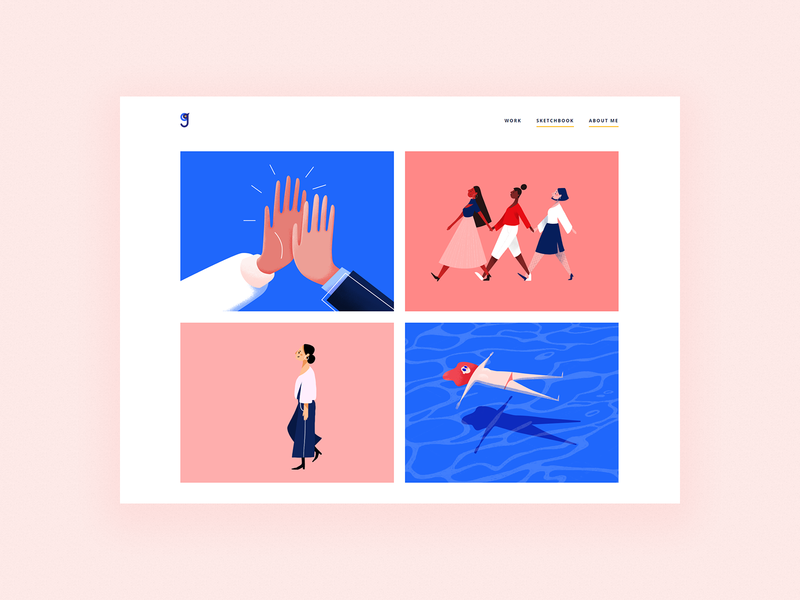In this sponsored post written by our friends at Domain.ME, learn how your personal branding is crucial to the success of your career and how to start investing in it.
Your story is the greatest tool you have—so why not tell it to the world?
We’ve all heard about the power of storytelling. When used correctly, stories can captivate an audience, build human connections, and create memorable experiences. But what does all of that have to do with your personal brand? Think of it this way:
All of us have a story to tell. And all of us—whether we’re aware of it or not—have been cultivating our personal brands for years. But have you ever stopped to think about whether the personal brand you’ve been cultivating reflects the story you want to tell?
Well, that really depends on your goals. If you’re a creative professional, you probably want your personal brand to attract your dream clients and target the kind of work that aligns with your values. In this article, we’ll share three storytelling techniques you can use to build a strong personal brand that does just that.
But first things first, let’s dig into why your personal brand really matters in the first place, and what it can do for you.
Why your personal branding matters
Not so long ago, “personal branding” was a buzzword that would get thrown around in a lot of conversations about career development. Believe it or not, it was often described as a narcissistic or vain attempt to packaging yourself. But today, personal branding has evolved into so much more than a futile marketing gimmick.
Simply put, your personal brand is how someone perceives you. In other words, it’s the impression you give off to others. When we want to leave a lasting good impression on someone, we make sure to present ourselves in the best possible light. That’s not to say that we’re faking or limiting parts of ourselves, but rather showing the side of ourselves that matters for the job or the situation at hand. And that is what personal branding is all about.
“A personal brand is how you present yourself to potential clients. You wouldn’t go to an interview wearing flip flops and a tank top, so why wouldn’t you care about how your brand looks?” — Murilo from Murilo.me
Now that we’ve discussed why personal branding matters, here are 3 ways you can start investing in yours.
1. Create a personal website
Ah, the nightmare called “the personal website”. We’ve all been there, and some of us are still putting off creating ours. But before we get into why having a website is so crucial to your personal brand, let me tell you a little story:
I have this friend, a graphic designer, who for years refused to build a personal website. His excuses varied from ‘I already share my work on social media, my CV is on LinkedIn, why would I bother with a website too?’ or ‘It takes ages to build a website, not to mention I’m not a developer’. As you can imagine, I had a few rebuttal points on why a website was so incredibly necessary.
All I’ll say is this: Two months after my friend launched his website, he landed a job at a well-known design company. His employer told him, ‘We are really impressed with your website. It really caught our eye.’
Why do you need a personal website?
Having a website ultimately helps you influence the first impression you have on people. By now we all know job recruiters Google us when we respond to their job postings. And if you’re anything like me, you’ll never be satisfied with your Google Search results. The same goes for the 48% of people who Googled themselves.
Creating a personal website will not erase your previous history on Google but it will help you own the result pages. How? By appearing right there alongside your Dribbble, LinkedIn and other social media profiles you have.
Think of a personal website as your online business card that is available 24/7. It introduces you to the world, highlights your work, past experiences, and any other vital information about yourself. There are no restrictions on templates and the format in which you can present your work. And most importantly, having a personal website means you’ll appear more professional to prospective clients.
2. Develop a narrative
Ready for another story? At the beginning of my career as a writer and as a person of many interests, I dabbled in pretty much anything I found interesting. Naturally, after a while, my portfolio resembled what some might have called a ‘jack of all trades, master of none’.
I remember having had a hard time being selected for larger projects or being perceived as an experienced writer in a given field. My inbox was filled with “Unfortunately, we are seeking a more experienced writer in the field of…”, and it took me a while to understand why.
You are allowed (and in most cases encouraged) to explore different areas of your profession. It might be that you’re interested in two things and want to specialize in both. But to avoid appearing like a dilettante to a potential client, the way you present your work is vital.
Instead of throwing it all together and hoping for the best, you need to develop a narrative. This is where your personal website comes in handy, as it allows you to compartmentalize your work. Dedicate one page to your logo and brand identity work, another to UI/UX, and possibly a third to animation, for example. The key is to point towards your assets and knowledge in each of the fields. Highlight your strengths and guide your clients through the experience.
If you’re transitioning from one field to another, focus on explaining how previous experiences have helped you gain a more competitive edge. Don’t leave anything up to interpretation—take ownership of your narrative and guide clients through your work. If that entails rebranding, so be it! It’s important to put your best foot forward and demonstrate to clients that the shift in your career is not an impairment, but an advantage that will give them a better product.
“If you want to stand out from the sea of people sending their websites and resumes to their clients and future employers, you definitely want to have your own unique voice that represents your brand. That’s why at the beginning of the year, I chose to rebrand my website and give it my own unique touch. Since then, I’ve had more success reaching out to clients and jobs because my website is a reflection of me and what I represent as an artist.” — Alec from Alecgiorgio.me
3. Demonstrate your ability to get the job done (perfectly)
You wouldn’t buy a product without seeing or reviewing it first, right? You’re also likely to hesitate to buy a product that has been poorly presented, and instead check out a direct competitor. Believe it or not, the same applies to your design portfolio and how you present your projects. Presenting your work thoughtfully and intentionally is vital for standing out in a sea of your competition.
Completing a challenging client project is always satisfying, but preparing the project for your website can be a dreaded activity. Sure, it takes time and considerable effort to prepare mockups and write a description of the project you’ve worked on, but it will pay off in the long run.
Not all project presentations will make sense to your clients. Showcase your projects by focusing on focal points for a client, rather than presenting what you liked the most about a given project. Remember, just like you are focusing on the client’s needs when creating solutions for them, the same holds true for project presentation. The focus should always be to show how your skills can help clients achieve their goals.
“The purpose of showing your work in detail is to convince your future client that the creation process is not simple but complex. You bring value to your work when you explain the steps and thought processes that helped you achieve the end result.” — Igor from ayroldes.me
Pro Tip: Show your work in progress
Dedicating a page on your website to the process of your work will help prospective clients see how you work and think about different solutions. This will ultimately help clients decide whether you’re the right fit for them. As with projects, it’s important to focus on the aspects that are important to clients. Go through your past project briefs and try to pick out what your client ultimately hoped to accomplish. Then, showcase how your creations helped them get there.
Start investing in your personal brand today
Now that you know the three most important pillars of a strong personal brand (and why you need one!), get out there and tell the world your story. Start taking ownership of your online presence, craft a compelling narrative around your work, demonstrate your value to clients, and you’ll be well on your way to building a brand that captivates the audience you seek. ■
About the author: Tijana Ostojic is a Marketing Specialist at Domain.ME, the international tech company that operates the internet domain “.ME.” Writer at heart, she appreciates great content and focuses her attention on bringing light to the importance of personal branding.
Find more Process stories on our blog Courtside. Have a suggestion? Contact stories@dribbble.com.













